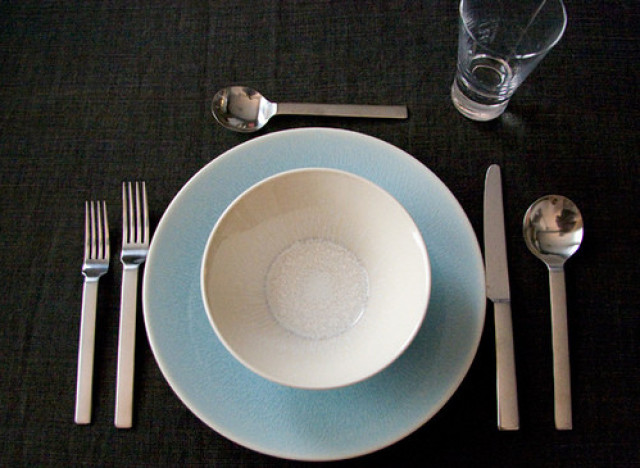
Flickr photo by Dinner Series
A dining table might be an important purchase, but it's what you put on top that can make a big difference. Think about it: A crisp white tablecloth can elevate a Sunday dinner into an occasion, while an artsy pattern can turn a table into a focal point. The issue? Finding a tablecloth--really, any kind--can be an exercise in frustration. No wonder most people nix the idea altogether.
But with these basic pointers, you can winnow the options down to the best of the bunch. From the
Material.Unless you plan on inviting the Queen to brunch, you absolutely do not need to even glance in the direction of luxury linen tablecloths. (Though we're certainly not going to stop you.) The rest of us will do just fine with a cotton-polyester blend. A 40/60 blend (cotton/polyester) is standard, which means you'll get the crisp look of cotton combined with the easy care of polyester. However, the higher the polyester content, the shinier the cloth.
Size. Most tablecloths generally have around a 50" or higher width. And remember that tablecloths should always be larger than the table it's covering and it should hang about 3"-5" over the table edges. So, stay on the more generous side of the size spectrum.
Shape. Keep in mind the general shapes for tablecloths, which are circle, square, rectangular, and oval. Obviously, you should match the tablecloth shape to your table's. But that's not a hard-and-fast rule. You can get away with using an oval cloth on a rectangular table, or a circle cloth on a square table...just not vice-versa.
Cost. Let's be honest, a good tablecloth shouldn't cost more than $50. If you're thinking about buying something above that price point, then it's probably more for the designer's name (we've seen polyester tablecloths by fancy designers go for $150, which is ridiculous) and occasionally for luxury linens.
Color/Pattern. White is obviously the standard when it comes to tablecloths, but it can be difficult to care for. Ivory and off-white tend to look dingy in a room that has lots of color, but fits in beautifully amongst wood and neutral-toned rooms. For fall, a chocolate-hued tablecloth makes a festive (but not too theme-y) impression. Patterns add visual interest (and can hide small stains), though they can be a bit busy if the pattern is out-there. To be on the safe side, choose a pattern in a simple color scheme.
Washability. Hands down, a cotton-polyester blend will be easiest to care for, since it doesn't really wrinkle and can be thrown into the wash without too much worry. If you've bought linen or 100% cotton, it's probably best to have the tablecloth professionally laundered.
Want to get a little shopping out of the way? Here's a selection of our favorite picks for any budget. Or, go the DIY approach with the video below.